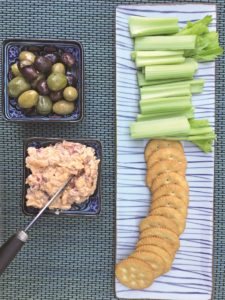One advantage to being a gardener is that I don’t mind the rain. In fact, I spend most of the growing season in Truro worrying about drought and longing for more rain. But even I felt a little let down as I peered out into the New England spring drear on the Sunday of Memorial Day weekend.
This isn’t the first storm-drenched Memorial Day I’ve waded through, but this year it came with an uncharacteristic feeling of disappointment. It seemed as if we’d been waiting for this weekend forever — or at least 14 months. Here we were, on the weekend that masks could come off (mostly) and people might gather and hug each other again, stuck inside, watching water drip off the deck furniture. Still, in spite of the rainstorm outside, in spite of everything, I found myself starting to think about guests.
I want to have folks over, to catch up, to hear how they’ve fared. I want to look at friends in three dimensions. I want to serve people barbecue, and extravagant salads, and garden peas turned in butter and mint, and clams steamed with wine, and homemade strawberry ice cream.

Once I get started down this path it’s difficult to stop the ideas and plans. Yet, I’m really out of practice. After a year of serving meals for two, what I really want is to ease my way back in. I want to resist working myself into a frenzy baking savory shortbreads or pickling oysters. I want something easy to put together to have at the ready. Something that won’t strain my underused entertaining muscles and will make guests happy to be back.
I want pimento cheese.
When I was growing up in Louisiana, my mother — “Ms. Nev” to my friends — had a handful of dishes she would make when she wanted to do something special for my brothers and me. Peanut butter fudge, for example. Or fried donuts that she made with canned biscuit dough. Or crab dip served with Lay’s potato chips. And, of course, pimento cheese.
Pimento cheese was a product of the early days of the processed food industry, when the newly available blocks of bland, American-made “Neufchâtel-style” cheese were combined with canned Spanish pimiento peppers and sold commercially. Exactly how this original pimento cheese (the Spanish i in pimiento was quickly dropped) became a staple of Southern cuisine is clouded in mystery, and, really, who cares?
What we do know is that Southern mothers and grandmothers adopted and adapted the dish to make it their own. That’s how it got from being a Depression-era staple to becoming “the paté of the South.” There are as many recipes for pimento cheese as there are fans, but some ingredients remain constant — sharp, grated cheddar cheese, diced jarred pimento peppers, and mayonnaise.
I won’t open up the Duke’s vs. Hellman’s mayonnaise debate here. We used neither. My mother always used Blue Plate, as did everyone we knew. Back then, it was made right off Jefferson Davis Parkway in NOLA. The factory is fancy apartments now, but at least the parkway is named for Norman Francis. I don’t know exactly where it’s made, but it’s the brand my mother still uses, as would I were it available here. Use the best — whichever best you believe in. Likewise, use a favorite, flavorful hot sauce. The one I like is Crystal. It’s the go-to in New Orleans.
In some recipes, the cream cheese remains, though for some devotees, this is anathema. I’ve tried various recipes, and I like the cream cheese because it helps the texture to be both chunky and smooth. And anyway, that’s how Ms. Nev made it. I like to mix the pimento by hand, with a wooden spoon, to retain some of the texture of the grated cheese. Some folks grate the cheese into the bowl of a food processor and then add the other ingredients and whirl for a smoother spread.
Use the best quality cheddar you can lay your hands on. I’ve gone so far as to roast pimento peppers and even jalapeños to add a delicious smoky dimension, but we’re going for ease here, so this recipe sticks with the basics.
Pimento cheese can be kept in the refrigerator for a week (though it won’t last that long). When guests are coming, take it out and allow it to come to room temperature. You can spread it thinly on sliced bread, remove the crusts, and make little finger sandwiches — this was considered the height of hors d’oeuvrery when I was a kid. And there are tons of other ways to eat a good version of the South’s favorite spread — think grilled pimento cheese sandwiches or warmed pimento cheese on burgers. But I like to serve it just as my mother did, with celery sticks or Ritz crackers.
Ms. Nev’s Pimento Cheese
Yields about 1½ cups
Ingredients
8 oz. extra-sharp cheddar
2 oz. (about ¼ cup) cream cheese
½ cup jarred whole pimento peppers
3 Tbsp. mayonnaise
1 tsp. Worcestershire sauce
1 tsp. hot sauce, or more to taste
Get out the cream cheese to soften it. Drain the pimentos and pat them dry, then dice them fine.
Grate the cheddar into a large mixing bowl. Using a wooden spoon, work the softened cream cheese into the cheddar until it is more or less evenly distributed. Add the diced pimentos, mayonnaise, Worcestershire sauce, and hot sauce, and stir vigorously until the ingredients are well mixed and the cheese is spreadable (2 to 3 minutes).
It should be smooth, but also retain some of the texture of the cheddar.
Serve at room temperature or store in a tightly covered bowl in the refrigerator for up to a week.



